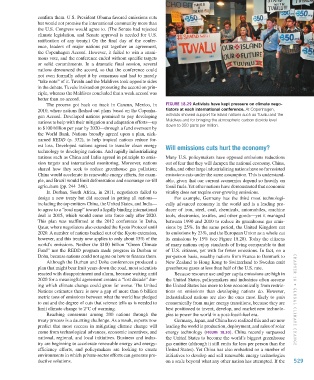Page 530 - Environment: The Science Behind the Stories
P. 530
confirm them. U.S. President Obama favored emissions cuts
but would not promise the international community more than
the U.S. Congress would agree to. (The Senate had rejected
climate legislation, and Senate approval is needed for U.S.
ratification of any treaty.) On the final day of the confer-
ence, leaders of major nations put together an agreement,
the Copenhagen Accord. However, it failed to win a unani-
mous vote, and the conference ended without specific targets
or solid commitments. In a dramatic final session, several
nations denounced the accord, so that the conference could
not even formally adopt it by consensus and had to merely
“take note” of it. Tuvalu and the Maldives took opposite sides
in the debate. Tuvalu insisted on protesting the accord on prin-
ciple, whereas the Maldives concluded that a weak accord was
better than no accord.
The process got back on track in Cancun, Mexico, in Figure 18.29 Activists have kept pressure on climate nego-
2010, where nations fleshed out plans based on the Copenha- tiators at each international conference. At Copenhagen,
gen Accord. Developed nations promised to pay developing activists showed support for island nations such as Tuvalu and the
nations to help with their mitigation and adaptation efforts—up Maldives and for bringing the atmospheric carbon dioxide level
to $100 billion per year by 2020—through a fund overseen by down to 350 parts per million.
the World Bank. Nations broadly agreed upon a plan, nick-
named REDD (p. 332), to help tropical nations reduce for-
est loss. Developed nations agreed to transfer clean energy Will emissions cuts hurt the economy?
technology to developing nations. And rapidly industrializing
nations such as China and India agreed in principle to emis- Many U.S. policymakers have opposed emissions reductions
sion targets and international monitoring. Moreover, nations out of fear that they will dampen the national economy. China,
shared how they seek to reduce greenhouse gas pollution; India, and other large industrializing nations have so far resisted
China would accelerate its renewable energy efforts, for exam- emissions cuts under the same assumption. This is understand-
ple, and Brazil would limit deforestation and encourage no-till able, given that our current economies depend so heavily on
agriculture (pp. 244–246). fossil fuels. Yet other nations have demonstrated that economic
In Durban, South Africa, in 2011, negotiators failed to vitality does not require ever-growing emissions.
design a new treaty but did succeed in getting all nations— For example, Germany has the third most technologi-
including the top emitters China, the United States, and India— cally advanced economy in the world and is a leading pro-
to agree to a “road map” toward a legally binding international ducer of iron, steel, coal, chemicals, automobiles, machine
deal in 2015, which would come into force only after 2020. tools, electronics, textiles, and other goods—yet it managed
This plan was reaffirmed at the 2012 conference in Doha, between 1990 and 2010 to reduce its greenhouse gas emis-
Qatar, where negotiators also extended the Kyoto Protocol until sions by 25%. In the same period, the United Kingdom cut
2020. A number of nations backed out of the Kyoto extension, its emissions by 23%, and the European Union as a whole cut
however, and this treaty now applies to only about 15% of the its emissions by 15% (see Figure 18.28). Today the citizens
world’s emissions. Neither the $100 billion “Green Climate of many nations enjoy standards of living comparable to that
Fund” nor the REDD program made progress in Durban or of U.S. citizens, yet with far fewer emissions. In fact, on a
Doha, because nations could not agree on how to finance them. per-person basis, wealthy nations from France to Denmark to
Although the Durban and Doha conferences produced a New Zealand to Hong Kong to Switzerland to Sweden emit
plan that might bear fruit years down the road, most scientists greenhouse gases at less than half of the U.S. rate.
reacted with disappointment and alarm, because waiting until Because resource use and per capita emissions are high in
2020 for a meaningful agreement creates a “lost decade” dur- the United States, policymakers and industries often assume
ing which climate change could grow far worse. The United the United States has more to lose economically from restric-
Nations estimates there is now a gap of more than 6 billion tions on emissions than developing nations do. However,
metric tons of emissions between what the world has pledged industrialized nations are also the ones most likely to gain
to cut and the degree of cuts that science tells us is needed to economically from major energy transitions, because they are CHAPTER 18 • Glob al Cli M aT e Chan G e
limit climate change to 2°C of warming. best positioned to invent, develop, and market new technolo-
Reaching consensus among 200 nations through the gies to power the world in a post-fossil-fuel era.
treaty process is a daunting challenge. As a result, experts now Germany, Japan, and China have realized this and are now
predict that most success in mitigating climate change will leading the world in production, deployment, and sales of solar
come from technological advances, economic incentives, and energy technology (Figure 18.30). China recently surpassed
national, regional, and local initiatives. Business and indus- the United States to become the world’s biggest greenhouse
try are beginning to accelerate renewable energy and energy- gas emitter (although it still emits far less per person than the
efficiency efforts, and policymakers are looking to create United States). Yet China has also embarked on a number of
environments in which private-sector efforts can generate pro- initiatives to develop and sell renewable energy technologies
ductive solutions. on a scale beyond what any other nation has attempted. If the 529
M18_WITH7428_05_SE_C18.indd 529 12/12/14 4:05 PM

